All fruits are healthy, but some are healthier than others. Some fruits have a higher level of fructose (aka fruit sugar) while others come with low or minimum content. Skipping sugar is the new trend but cutting off sugar completely from the diet is not a wise decision. You can switch to low-fructose fruits because fruits are quite essential for our body as they contain vitamins and vital nutrients.
People switch to the low fructose diet for multiple reasons including gastrointestinal distress, controlling their diabetes, losing belly fat, and the list goes on. There’s no doubt that fruits are best for satisfying your sweet tooth instead of eating unhealthy junk.
Even though fruits are full of nutrients, there are some fruits with high sugar content, like mangoes or bananas. Most people with Irritable Bowel Syndrome (IBS) and Gastrointestinal tract (GIT) disorder develop fructose intolerance and have to switch to low-fructose foods.
Do you know which fruit contains less sugar than others? No worries! We are here to guide you. In this article, we’ll look at the list of the best low-fructose fruits list for people with, excessive belly fat, GIT problems, obesity, IBS, and other health conditions.
But First, What is Fructose?
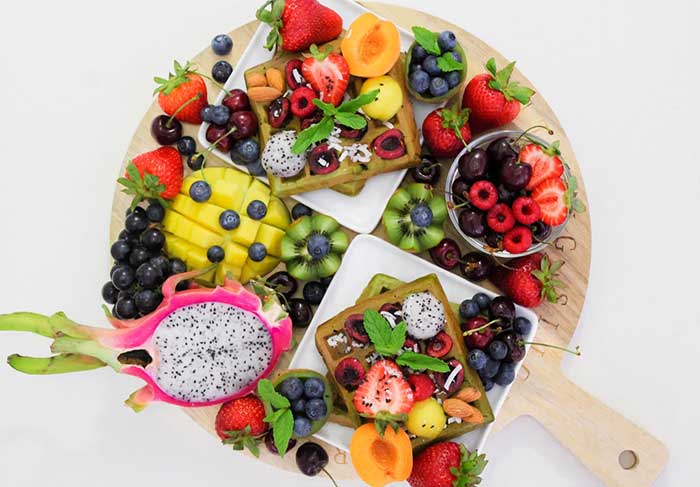
Fructose belongs to the monosaccharides group of sugar. It naturally exist in fruits and vegetables. A gram of fructose provide 4 calories. Fructose or crystalline fructose occurs naturally in honey, fruits, sugar beet, sugar cane, flowers and many vegetables. It is often bonded to glucose to form the disaccharide sucrose (aka table sugar), contains Glucose and Fructose in an exact 50:50 ratio.
Fructose is one of the three dietary monosaccharides, along with glucose and galactose. Glucose is directly absorbed in the blood stream as this is the primary energy source of every cell in our body. On the other hand Fructose and Galactose are first converted in Glucose by the liver then absorbed in the blood stream.
Though fructose is a natural and organic sugar, it can still be synthesized commercially in form of crystalline fructose & D-fructose. These forms then used in the manufacturing of many sweet products, snacks and Beverages.
Although fructose is healthier, but it still has some drawbacks.
Fructose is almost twice as sweet as table sugar. It is unhealthy to consume in large quantities. Consuming extra fructose can overfill your liver – leading to fatty liver disease, high blood pressure, overeating, and obesity. Additionally, it’s dangerous for individuals with diabetes. Therefore, diabetic people need to be more cautious about consuming food high in fructose.
What are Low Fructose Fruits and Why are they Good for you?

Luckily, there are numerous fruits low in fructose found in nature. People with fructose intolerance need to cut off high-sugar fruits. You might be thinking what does fructose intolerance mean? It’s a condition where a normal amount of fructose can’t be absorbed by the body.
Switching to low-fructose fruits is a good idea if you’re diabetic, obese, or have GIT problems since they are good for meeting the sugar requirements of the body. Whether you’re on a diet or have health issues low fructose fruit will fit perfectly in your eating chart.
Also Read: Anti-Aging Foods
Top 18 Low Fructose Fruits that are Healthy and Also Yummy!
Fruits are the best source of minerals and vitamins essential to our body. Instead of living a life without eating fruits, you can simply make a list of low-fructose fruits to promote health. Here’s a list of fruits that are good enough to satisfy your sweet tooth without disturbing the required sugar level. Keep in mind that the nutritional value in low fructose fruits charts below is per 100g of fruit.
1. Lemons or Lime

Lemon and Lime are common fruits that have the lowest fructose content compared to fruits like apples and pears. They are rare to eat as a fruit, but you can mix lemon & lime juices with anything to add tartness and improve the flavor. These nutrient-rich fruits are high in Vitamin C and antioxidants – such as flavonoids and limonoids – that help cancel out dangerous free radicals in the body.
They fight the common cold, reduce blood pressure, and boost the immune system. In addition, they reduce oxidative stress, relieve constipation, and improve overall health. FODMAPs (fermentable, oligosaccharides, disaccharides, monosaccharides, and polyols) are a sort of carbohydrate which initiate digestive issues in a handful of individuals.
You can add a slice of lemon to water to control your hunger since it is known for helping with weight loss. So, you do not need to take long walks to burn those extra calories. Nothing beats the summer heat like a chilled glass of low-calorie lemonade!
The nutritional details in 100g pure fruit include:
| Contents | Lemon | Lime |
|---|---|---|
| Fructose | 2.5g | 1.0g |
| Calories | 29 kcal | 30 kcal |
| Fats | 0.3 g | 0.2g |
| Carbohydrates | 9.3g | 8.42g |
| Proteins | 1.1g | 0.67g |
| Fiber | 2.8g | 2.8g |
2. Oranges
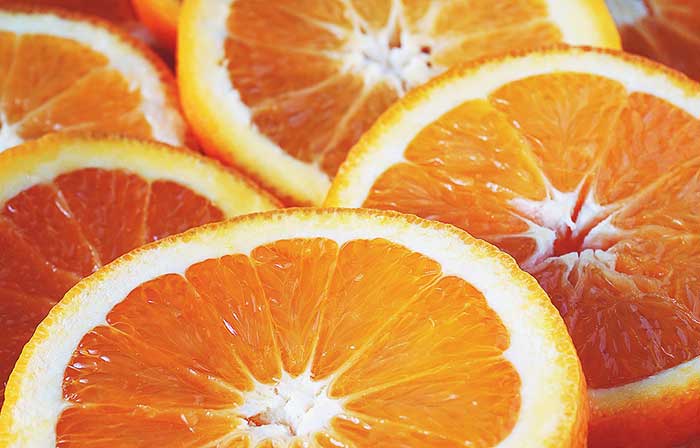
Oranges are the most popular juicy and healthy snack in winter and one of the best low-fructose fruit. Alongside all other citrus fruits, oranges are packed with essential vitamins that include; vitamins A and C – improving the immune system and reducing the chances of chronic diseases.
It contains 2 to 3 grams of fructose per 100g, depending on the ripeness of the orange. An excellent fruit for fructose intolerance and malabsorption, as it contains low fructose content.
According to many health professionals the flavonoids and trace minerals in oranges also play a vital role in improving metabolism and preventing cardiovascular diseases, and obesity, boosting iron and collagen synthesis in the body. The nutritional value is beneficial when you’re on a diet. In 100g pure orange include:
| Contents | Orange |
| Fructose | 2.4g |
| Calories | 43 kcal |
| Fats | 0.2g |
| Carbohydrates | 8.2g |
| Proteins | 0.8g |
| Fiber | 2.4g |
Read Also: Low-Carb Pasta Recipes
3. Berries

Berries come in a batch of small plump fruits that are delicious and packed with multiple nutrients. If you’re seeking a low-fructose diet-friendly friend, berries are the most popular choice. Most berries – strawberries, blueberries, blackberries, raspberries, etc. contain low fructose.
Several types of antioxidants like anthocyanins and especially vitamin C are beneficial for overall health. Being rich in minerals, they reduce the risk of chronic diseases in the body like heart diseases and cancers and also aid the immune system.
In addition, studies have shown that how berries show a positive effect on cardiovascular health.
Nutrition Figures for Blueberries:
| Contents | Strawberry | Blueberry | Blackberry | Raspberry |
| Fructose | 2.9g | 4.66g | 2.9g | 2.53g |
| Calories | 32 kcal | 57 kcal | 43 kcal | 53 kcal |
| Fats | 0.3g | 0.33g | 0.4g | 0.65g |
| Carbohydrates | 7.68g | 14.5g | 9.0g | 11.9g |
| Proteins | 0.67g | 0.74g | 1.3g | 1.2g |
| Fiber | 2.0g | 2.4g | 5.3g | 6.5g |
4. Kiwi

This green-colored odd fuzzy fruit is also considered a part of the berries family. Not to be confused; there are two varieties of the same fruit. First is kiwi fruit, and the other is a kiwi berry, the smaller, bite-sized version that doesn’t require peeling. Both taste incredibly delicious.
This fruit is perfect for people with fructose malabsorption due to its low fructose content. Kiwi contains vitamins A, C, E and K – aiding the whole body. Due to the high fibers, kiwis aid in many digestive benefits.
This fruit helps to reduce bloating, inflammation, and gastric issues – alongside digestion. Eating this fruit will put you in a win-win situation.
| Contents | Kiwi |
| Fructose | 4.2g |
| Calories | 61 kcal |
| Fats | 0.5g |
| Carbohydrates | 14.7g |
| Proteins | 1.1g |
| Fiber | 3.0g |
5. Grapefruit
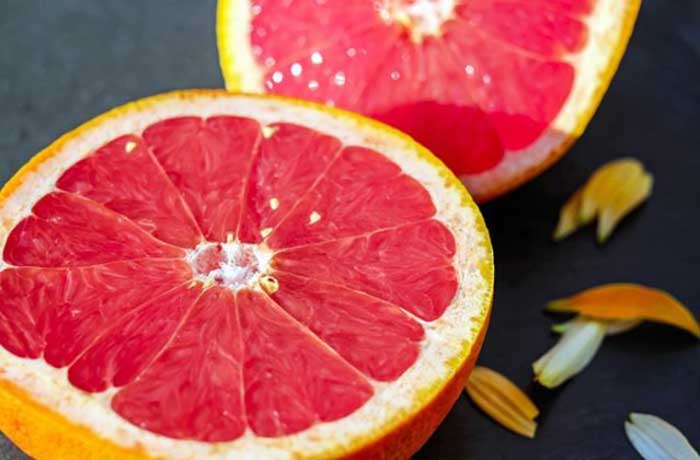
They are known to be a low-sugar breakfast food. A medium or half grapefruit contains about 7g of sugar, but they aren’t sweet compared to grapes. It’s better to add some drops of honey if the taste is sharp for your preference. This tropical fruit is high in nutrients but low in calories, as it’s an ideal fruit for decreasing belly fat.
Grapefruit has low fructose but has natural sugars like sucrose and glucose – contributing to the sweet flavor and carbohydrate content. A study revealed that adding grapefruits to your diet may prevent diabetes as it controls insulin levels in the blood. It is also high in antioxidants that fight numerous diseases and infections.
| Contents | Grapefruits |
| Fructose | 2.6g |
| Calories | 42 kcal |
| Fats | 0.14g |
| Carbohydrates | 10.7g |
| Proteins | 0.77g |
| Fiber | 1.6g |
6. Avocado
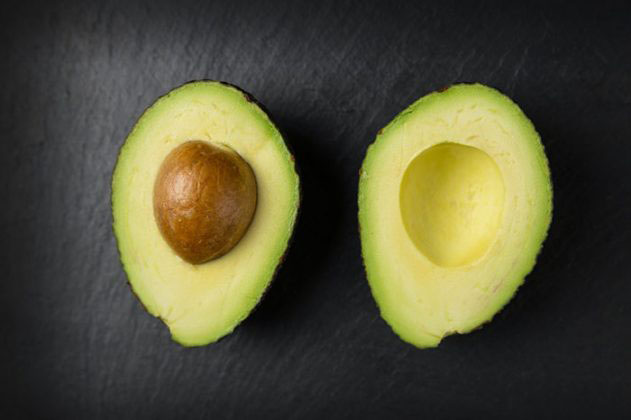
The fruit that you might never love to eat is Avocado. While making a low-sugar fruit list, most people forget to count it as a fruit. However, Avocados contain zero sugar, literally a sugar-free fruit. They are deemed low in FODMAPs for individuals with IBS or further gastrointestinal sensitivity.
Moreover, they are jam-packed with essential nutrients such as, healthy fats – Vitamins C, E, and K, riboflavin, Magnesium, niacin, pantothenic acid, etc – that help minimize hunger. High amounts of fiber in avocados promote gut health and increase gut biodiversity.
In addition, it aids in weight loss and healthy body weight maintenance. They lower the risk of heart issues and are especially beneficial during pregnancy and breastfeeding.
| Contents | Avocado |
| Fructose | 0.66g |
| Calories | 160 kcal |
| Fats | 14.66g |
| Carbohydrates | 8.53g |
| Proteins | 2.0g |
| Fiber | 6.7g |
7. Watermelon

Watermelon is an iconic fruit of summer and a favorite of everyone. Eating watermelon seems like a treat. One bite of watermelon on a hot day of summer feels like heaven. Thankfully, they are low on sugar, as they contain 80% water that will keep you hydrated and cool.
A cup of watermelon cubes holds less than 7g of sugar, making it a more suitable option for somebody who suffers from fructose malabsorption. The glycemic index in watermelon is moderately low and includes essential vitamins like vitamin C, A, and magnesium.
It’s furthermore known – to lower blood pressure, raise energy levels, prevent heart and kidney issues, and enhance eyesight. Plus, watermelons are great for clear skin. They keep it hydrated, prevent pimples and wrinkles, and repair skin cells faster.
| Contents | Watermelon |
| Fructose | 1.5g |
| Calories | 30 kcal |
| Fats | 0.2g |
| Carbohydrates | 7.6g |
| Proteins | 0.6g |
| Fiber | 0.4g |
8. Cantaloupe
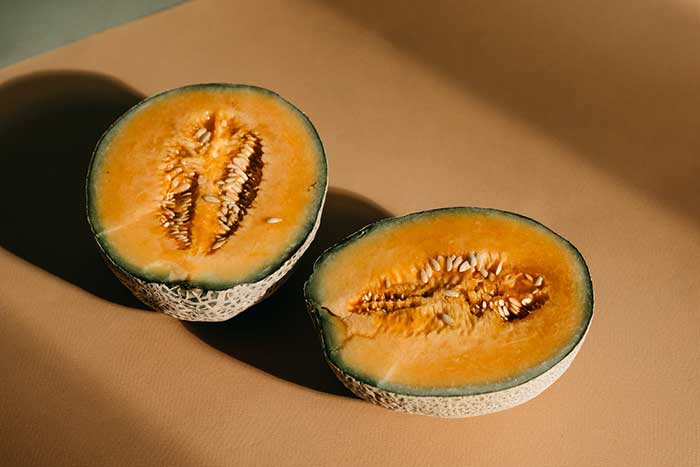
Did you know that cantaloupes are associated with watermelons? While they share many attributes, there is one key difference. Cantaloupes are rich in beta-carotene and possess less than 10g of sugar. Additionally, the potassium in this refreshing summer fruit can support heart health and decrease blood pressure.
Cantaloupes also contain necessary minerals like vitamin B-complex and K. They have high water scope, electrolytes, and fiber that aid hydration and digestion. Individuals with diabetes can benefit from cantaloupes as they have a low glycemic index and calorie count. Some sources suggest that cantaloupes may even have skin and health benefits.
| Contents | Cantaloupe |
| Fructose | 3.4g |
| Calories | 34 kcal |
| Fats | 0.2g |
| Carbohydrates | 8.2g |
| Proteins | 0.8g |
| Fiber | 0.9g |
9. Apricots
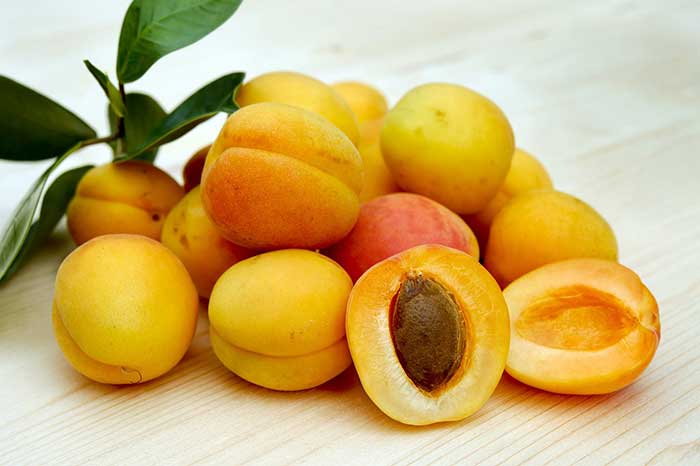
Apricots are delectable fruits that ripen in early summer and spring. They intrinsically contain sugar, which makes them an immaculate alternative for people with fructose malabsorption. It has a plentiful ratio of dietary fiber, which is beneficial for digestive health and regulates blood sugar levels.
It supplies all necessary nutrients and iron to the body. Apricots are low in fat and calories, alongside having Vitamin A and potassium; that promotes the immune system and healthy liver function. Additionally, it improves gut, skin, and eye health through vitamins E, C, and A, beta carotene, and other essential trace minerals.
Make sure to intake fresh apricots rather than dried apricots – if you’re looking to have it for fructose intolerance – as the sugar becomes more concentrated when dried.
| Contents | Apricots |
| Fructose | 3.2g |
| Calories | 48 kcal |
| Fats | 0.1g |
| Carbohydrates | 11.0g |
| Proteins | 1.4g |
| Fiber | 2.0g |
10. Papaya
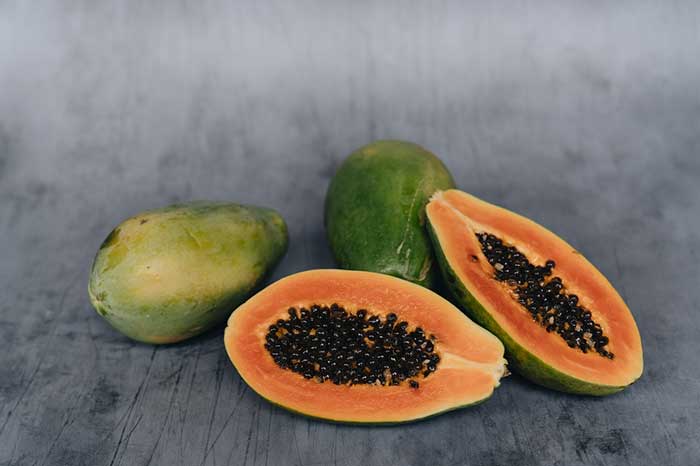
Papayas are a must for any fruit with a low fructose list. It is a tropical fruit that is also rich in vitamin C. They are an excellent source of antioxidants that help neutralize harmful free radicals in the body. It also has anti-cancer properties and fights infections and various inflammations.
According to the studies, papaya may prevent the chances of Alzheimer’s disease. They are commonly low in calories, making them the perfect diet meal option. Potassium in the papayas aids heart-related issues and regulates the blood pressure in the body.
It’s a common remedy for people with IBS to eat lots of papayas because the papain enzyme speeds up digestion and reduces bloating & constipation. So, the next time you’re suffering from painful cramps and stomachaches, eat a cup of papaya. Its nutritional values are:
| Contents | Papaya |
| Fructose | 1.8g |
| Calories | 43 kcal |
| Fats | 0.4g |
| Carbohydrates | 10.8g |
| Proteins | 0.5g |
| Fibers | 1.8g |
11. Peaches
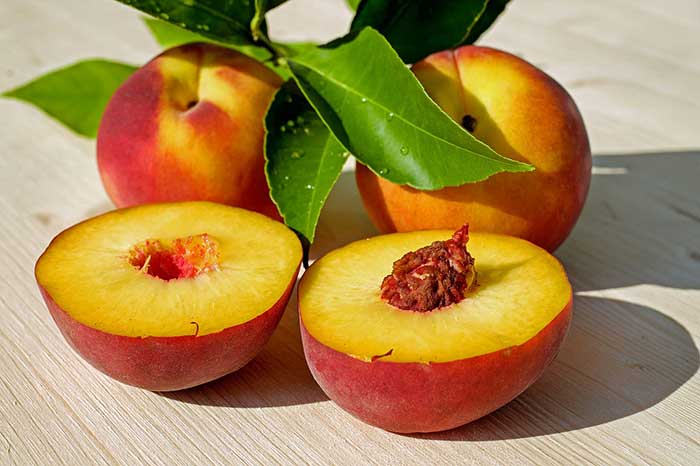
This sweet fruit with a fuzzy peel is popular with many people. And rightfully so. It has essential nutrients that aid heart and immune health. It’s perfect for people with fructose intolerance (who have difficulty absorbing fructose in the small intestine). Additionally, peaches contain very little sorbitol – sugar alcohol – in regards to other fruits like plums which cause gastrointestinal discomfort.
Due to their high fiber content, they prevent digestive disorders and increase gut bacteria. When applied directly on the skin, a mask is formed to moisturize and protect the skin from infections, significantly reducing acne and other skin disorders. 100g ( a small peach) contains:
| Contents | Peaches |
| Fructose | 2.6g |
| Calories | 39 kcal |
| Fats | 0.3g |
| Carbohydrates | 9.5g |
| Proteins | 0.9g |
| Fiber | 1.5g |
12. Coconut

Coconut is a popular fruit due to its various culinary and cosmetic applications. Coconut-derived developments are consumed – like coconut milk, coconut oil, coconut flakes, and more for universal causes.
Its health benefits contain antioxidant, anti-inflammatory, and anti-bacterial effects. It is also helpful in obesity and weight loss. Moreover, drinking coconut water and coconut milk reduces blood sugar content and controls blood pressure.
It’s easy to add to your daily diet. Grate some coconut flakes on top of tasty dishes, substitute regular milk with coconut milk and regular flour with coconut flour in baking, cooking, etc. You can also drink coconut water. A small cup (100g) of coconut contains:
| Contents | Coconut |
| Fructose | 1.3g |
| Calories | 354 kcal |
| Fats | 33.49g |
| Carbohydrates | 15.32g |
| Proteins | 3.33g |
| Fiber | 9.0g |
13. Pumpkin
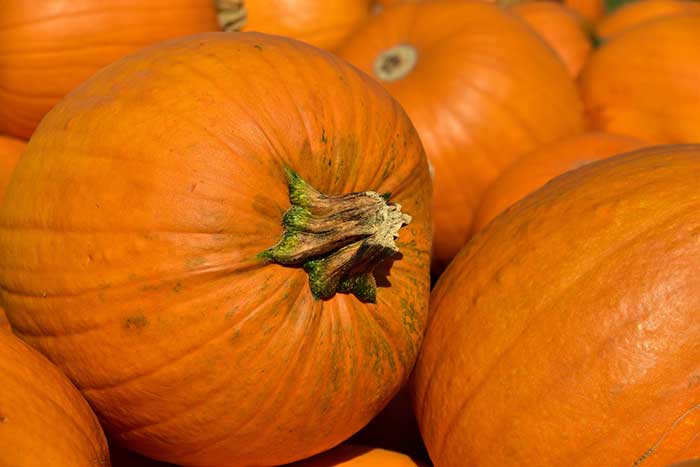
Autumn is incomplete without pumpkins. They are a Halloween staple, after all. Pumpkins are only around for a short while, so most people are unaware of their health benefits and low sugar content, a great fruit low in fructose. All parts of a pumpkin – flesh, seeds, and leaves – are edible. Each has its unique advantages and use.
Pumpkin flesh makes pies, purees, soups, salads, etc. We all know and love the famous Pumpkin spice latte, don’t we? Pumpkin is among the best low-fructose fruits out there. You can munch on dried & roasted pumpkin seeds as snacks or add them to other tasty recipes.
They’re packed with antioxidants and iron that lower cholesterol and prevent heart diseases. Some studies highlight pumpkin seeds help in treating insomnia and improve sleep quality. 100g of pumpkin contains:
| Contents | Pumpkin |
| Fructose | 0.6g |
| Calories | 26 kcal |
| Fats | 0.1g |
| Carbohydrates | 6.5g |
| Proteins | 0.6g |
| Fiber | 0.5g |
14. Pineapple
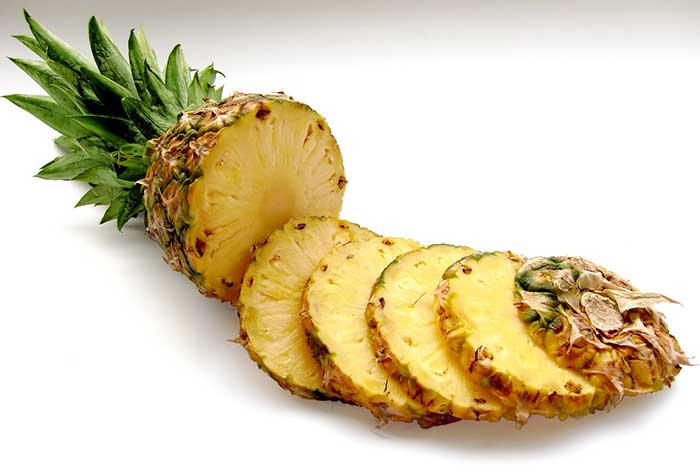
Who doesn’t enjoy a delicious slice of freshly cut pineapple? Not only does it stimulate a beachy vibe, but it also presents multiple health benefits. Pineapples are low in sugar and high in crucial minerals and antioxidants.
They are exceptionally rich in all required vitamins and minerals. The precise fructose content varies depending on the ripeness and amount consumed by the average person. Pineapples include a group of enzymes called bromelain, which boosts digestive health.
Frequent consumption of pineapple can help lessen chronic inflammation and prevent diabetes, heart disease, certain cancers, and arthritis. Its nutritional values are:
| Contents | Pineapple |
| Fructose | 2.5g |
| Calories | 50 kcal |
| Fats | 0.1g |
| Carbohydrates | 13.1g |
| Proteins | 0.5g |
| Fiber | 1.4g |
15. Honeydew Melon
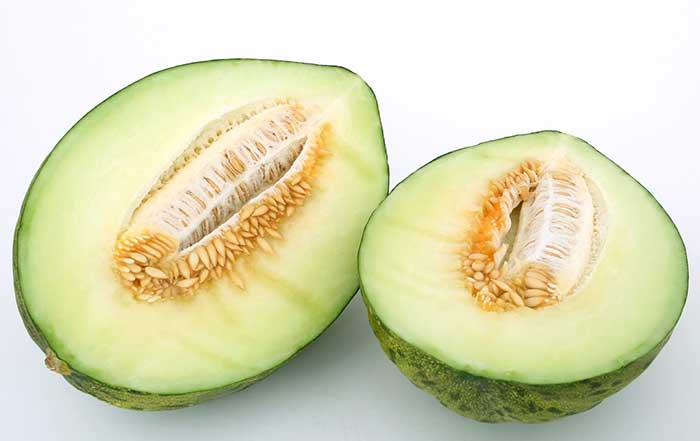
Honeydew melon is low-fructose fruit packed with nutrients to help you maintain a healthy lifestyle. It’s low in sugar but high in essential vitamins and minerals that regulate blood pressure and increase bone density, making them stronger. The fruit is also rich in water and electrolytes for proper hydration.
Despite its natural sweetness, it’s an excellent choice for sweet tooth with fructose malabsorption and those looking to lose weight due to its low-calorie count. The presence of glucose and sucrose makes it a healthy option for everyone. Honeydew melons also have numerous benefits for the skin.
They are low in calories and natural sugar, which helps to satisfy sweet cravings. So, enjoy this delicious and nutritious fruit this summer to enhance your health! A small cup (100g) of honeydew melon has:
| Contents | Honeydew Melon |
| Fructose | 3.4g |
| Calories | 36 kcal |
| Fats | 0.1g |
| Carbohydrates | 9.1g |
| Proteins | 0.5g |
| Fiber | 0.8g |
16. Cranberries
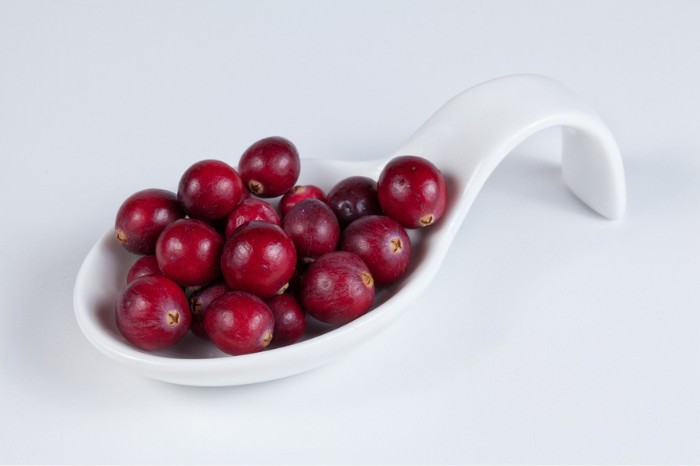
Cranberries have a tart and slightly sweet taste. You can eat it raw or make it into juices or cocktails. They are super low in fructose and loaded with vitamins and antioxidants. They bring a ton of health benefits to the table. Research shows that cranberries might help slow down cancer progression. They do this by making cancer cells die and cutting down inflammation.
Eating 1 cup (100 grams) of raw cranberries include:
| Contents | Cranberries |
| Calories | 46 |
| Water | 87% |
| Protein | 0.4g |
| Carbs | 12.2g |
| Sugar | 4g |
| Fiber | 4.6g |
| Fat | 0.1g |
17. Rhubarb

Rhubarb is considered both a fruit and a vegetable. It is low in calories and fructose and provides vitamin C, vitamin K, and potassium. Its one-of-a-kind flavor and versatility make it a favorite ingredient in tons of seasonal recipes. Rhubarb also stimulates intestinal function and promotes regular bowel movements. It is packed with antioxidants, like anthocyanins. These help fight inflammation and might lower your chances of getting chronic diseases like heart disease and cancer.
When you eat 100 grams of Rhubarb, you get:
| Contents | Rhubarb |
| Calories | 116 |
| Carbs | 31.2g |
| Fiber | 2g |
| Protein | 0.4g |
| Vitamin K1 | 18% of the DV |
| Calcium | 11% of the DV |
| Vitamin C | 4% of the DV |
| Potassium | 2% of the DV |
| Folate | 1% of the DV |
18. Passion Fruit

Passion fruit is a tropical delight that stands out as a tasty, juicy, low-fructose option. It contains only about 0.9 grams of fructose per fruit.
Besides its sweet and tangy flavor, passion fruit’s nutritional values make it a top choice. A single passion fruit provides about 17 calories and 2 grams of fiber. Plus, it’s a good source of vitamin C, making up 6-7% of the daily recommended intake. Its high fiber content aids digestion and promotes a feeling of fullness, making it a healthy choice for those monitoring their fructose intake. From smoothies to salads, enjoy passion fruit with a passion for better health.
| Contents | Passion Fruit |
| Energy | 97 Kcal |
| Carbohydrates | 23.38 g |
| Protein | 2.20 g |
| Total Fat | 0.70 g |
| Cholesterol | 0 mg |
| Dietary Fiber | 10.40 g |
Benefits of Low-Sugar Fruits
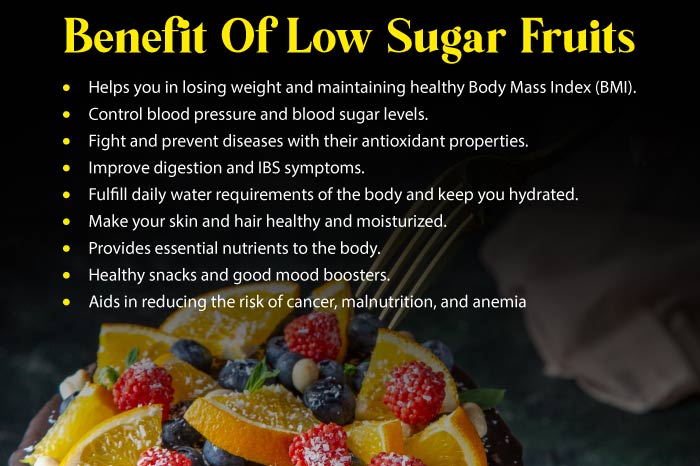
Regardless of the sugar level, fruits are healthier to eat and have so many benefits. There are numerous advantages of low-fructose fruits. Some of them are:
- Helps you lose weight and maintain a healthy Body Mass Index (BMI).
- Control blood pressure and blood sugar levels.
- Fight and prevent diseases with their antioxidant properties.
- Improve digestion and IBS symptoms.
- Fulfill daily water requirements of the body and keep you hydrated.
- Make your skin and hair healthy and moisturized.
- Provides essential nutrients to the body.
- Healthy snacks and good mood boosters.
- Aids in reducing the risk of cancer, malnutrition, and anemia
A Word of Caution about Sourcing Fruits
While it is true that fruits are healthy and nature’s gift to mankind. However, it is also true that most fruits available in the market today are not natural. Thanks to technological and agricultural advancements, fruits are genetically modified to be sweeter, have thinner skin, more juice, less fiber, and have longer shelf life. Not to mention all the toxic pesticides that are sprayed; are harmful to human beings. Truly, the fruits that are found in multinational grocery store chains and supermarkets are far from healthy. According to a report by National Geographic, fruits, and vegetables are less healthy today than they used to be.
To ensure that you are actually consuming “healthy”, low-fructose fruits, make sure you source them from a local farmer’s market. These are places where farmers sell their fresh produce directly to customers. It is more ethical as well as healthy. Moreover, only eat fruits that are in season. After all, it stands to reason that any fruit that is growing out of season must have some modifications done to it.
“Keep in mind – Only buy Local and Seasonal Fruits for maximum health benefits.”
How to Incorporate Low Fructose Fruits in a Meal?

It’s necessary to eat three meals a day, but as humans, we need to make sure that we eat as healthy as possible. As a person with fructose intolerance, it’s crucial to keep track of the diet. Most nutritionists recommend people take at least 2 ½ cups or 1 to 2 fruits daily, showing the matter of fruit despite the sugar level in our daily routine.
Moreover, a healthy diet with low-fructose fruits could lead to rapid weight loss. If you find it hard to add fruits to your diet, we have some suggestions for you.
Breakfast
Those who eat cereals or pancakes for breakfast should add slices of low-fructose fruits. You can also take a handful of berries with yogurt or make a yogurt parfait. Smoothies are healthy when they are made with any fructose-friendly fruit in them. Furthermore, satisfy your juice craving in the morning with lime water.
Adding drops of lime to sparkling water would not only help your digestion but also your skin. One thing to remember is that portion control is essential – excessive consumption of low-fructose food can be dangerous for malabsorption
Lunch
For lunch, you can make a salad by adding fruits with low fructose levels. Decorate your plate with avocado, topping with orange slices and berries. Moreover, you can add yogurt to enjoy a full-fruit dessert at noon. Add a few drops of honey if required.
Dinner
At dinner, you can take the fruit of your choice after the meal. You can also make a low-sugar dessert with fruits or a healthy smoothie. Moreover, you can make overnight oats using some of these fruits and have them for breakfast the next morning. Making a fruit cocktail or mojito drink to have with dinner is also a good idea.
Here are a couple of fruit salad recipes for you to enjoy your healthy low-sugar fruits!
Refreshing Summer Fruit Salad with Mint
Ingredients:
- 1 cup Pineapples
- 3 medium Kiwis
- ½ cup Strawberries
- ½ cup Blueberries
- 1 cup Honeydew melon
- 1 cup Peaches
- 1 whole Orange (half for dressing)
- The juice of 1 Lemon or Lime
- ½ cup Fresh Mint leaves
Directions:
- Dice all the fruits in neat little cubes. Make sure to keep them bite-sized to make it easy to eat.
- Put all the diced fruits in a big container.
- Chop some fresh mint leaves and mix them in with the fruits.
- Pour the juice of one big lime and half an orange over the fruits.
- Mix it well and refrigerate an hour before serving.
- You can also add sparkling water or club soda to this salad and turn it into a refreshing sorbet perfect for a hot summer day!
Avocado Fruit Salad
Ingredients:
- 3 medium avocados
- 1 cup raspberries
- 1 cup blueberries
- ½ cup spiced and roasted almonds
- 1 cup of thinly sliced peaches
- You can add other fruits of your choice as well
Dressing Ingredients:
- ½ cup olive oil
- 1 tbsp. orange zest
- ¼ cup orange juice
- 2 tbsp. balsamic vinegar
- ½ tsp. salt
- freshly ground pepper to taste
Directions:
- Chop and slice all the fruits and put them in a bowl or a plate.
- Mix in almonds. Optionally, you can sprinkle some mint on top as well.
- In a separate bowl, whisk together all the ingredients for the dressing until they are all well-blended.
- Drizzle it liberally on the salad and enjoy!
Final Words
There are endless ways to enjoy fresh fruits. You can snack on them as is, add them to your cereal or yogurt bowl, blend them in smoothies, toss them in salads, and whatnot! The important thing is that you find fruits and foods low in fructose and try to incorporate them into your daily diet. Surely, with all of them being high in essential nutrients, your health will improve. Not to mention, these low-fructose fruits are safe for diabetics as well.
So, forget about dietary restrictions & high-sugar content and get ready to relish your summer with these scrumptious, mouth-watering, and healthy fruits!





